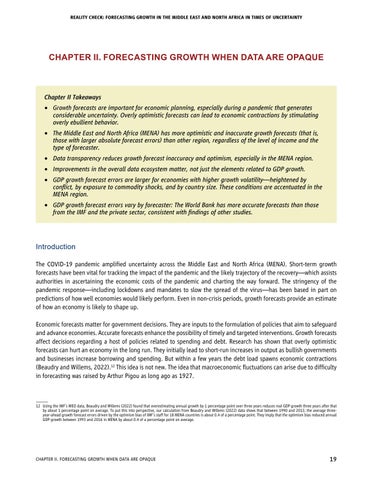REALITY CHECK: FORECASTING GROWTH IN THE MIDDLE EAST AND NORTH AFRICA IN TIMES OF UNCERTAINTY
CHAPTER II. FORECASTING GROWTH WHEN DATA ARE OPAQUE
Chapter II Takeaways • Growth forecasts are important for economic planning, especially during a pandemic that generates considerable uncertainty. Overly optimistic forecasts can lead to economic contractions by stimulating overly ebullient behavior. • The Middle East and North Africa (MENA) has more optimistic and inaccurate growth forecasts (that is, those with larger absolute forecast errors) than other region, regardless of the level of income and the type of forecaster. • Data transparency reduces growth forecast inaccuracy and optimism, especially in the MENA region. • Improvements in the overall data ecosystem matter, not just the elements related to GDP growth. • GDP growth forecast errors are larger for economies with higher growth volatility—heightened by conflict, by exposure to commodity shocks, and by country size. These conditions are accentuated in the MENA region. • GDP growth forecast errors vary by forecaster: The World Bank has more accurate forecasts than those from the IMF and the private sector, consistent with findings of other studies.
Introduction The COVID-19 pandemic amplified uncertainty across the Middle East and North Africa (MENA). Short-term growth forecasts have been vital for tracking the impact of the pandemic and the likely trajectory of the recovery—which assists authorities in ascertaining the economic costs of the pandemic and charting the way forward. The stringency of the pandemic response—including lockdowns and mandates to slow the spread of the virus—has been based in part on predictions of how well economies would likely perform. Even in non-crisis periods, growth forecasts provide an estimate of how an economy is likely to shape up. Economic forecasts matter for government decisions. They are inputs to the formulation of policies that aim to safeguard and advance economies. Accurate forecasts enhance the possibility of timely and targeted interventions. Growth forecasts affect decisions regarding a host of policies related to spending and debt. Research has shown that overly optimistic forecasts can hurt an economy in the long run. They initially lead to short-run increases in output as bullish governments and businesses increase borrowing and spending. But within a few years the debt load spawns economic contractions (Beaudry and Willems, 2022).12 This idea is not new. The idea that macroeconomic fluctuations can arise due to difficulty in forecasting was raised by Arthur Pigou as long ago as 1927.
12 Using the IMF’s WEO data, Beaudry and Willems (2022) found that overestimating annual growth by 1 percentage point over three years reduces real GDP growth three years after that by about 1 percentage point on average. To put this into perspective, our calculation from Beaudry and Willems (2022) data shows that between 1990 and 2013, the average threeyear-ahead growth forecast errors driven by the optimism bias of IMF’s staff for 18 MENA countries is about 0.4 of a percentage point. They imply that the optimism bias reduced annual GDP growth between 1993 and 2016 in MENA by about 0.4 of a percentage point on average.
Chapter II. Forecasting Growth when Data are Opaque
19

